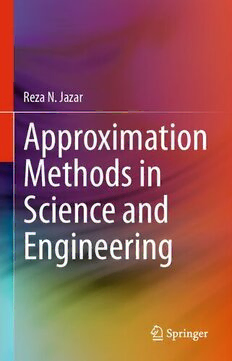Table Of ContentReza N. Jazar
Approximation
Methods in
Science and
Engineering
Approximation Methods in Science
and Engineering
Reza N. Jazar
Approximation Methods
in Science and Engineering
RezaN.Jazar
SchoolofEngineering
RMITUniversity
Melbourne,VIC,Australia
ISBN978-1-0716-0478-6 ISBN978-1-0716-0480-9 (eBook)
https://doi.org/10.1007/978-1-0716-0480-9
©SpringerScience+BusinessMedia,LLC,partofSpringerNature2020
Thisworkissubjecttocopyright.AllrightsarereservedbythePublisher,whetherthewholeorpartof
thematerialisconcerned,specificallytherightsoftranslation,reprinting,reuseofillustrations,recitation,
broadcasting,reproductiononmicrofilmsorinanyotherphysicalway,andtransmissionorinformation
storageandretrieval,electronicadaptation,computersoftware,orbysimilarordissimilarmethodology
nowknownorhereafterdeveloped.
Theuseofgeneraldescriptivenames,registerednames,trademarks,servicemarks,etc.inthispublication
doesnotimply,evenintheabsenceofaspecificstatement,thatsuchnamesareexemptfromtherelevant
protectivelawsandregulationsandthereforefreeforgeneraluse.
Thepublisher,theauthors,andtheeditorsaresafetoassumethattheadviceandinformationinthisbook
arebelievedtobetrueandaccurateatthedateofpublication.Neitherthepublishernortheauthorsor
theeditorsgiveawarranty,expressedorimplied,withrespecttothematerialcontainedhereinorforany
errorsoromissionsthatmayhavebeenmade.Thepublisherremainsneutralwithregardtojurisdictional
claimsinpublishedmapsandinstitutionalaffiliations.
ThisSpringerimprintispublishedbytheregisteredcompanySpringerScience+BusinessMedia,LLC
partofSpringerNature.
Theregisteredcompanyaddressis:1NewYorkPlaza,NewYork,NY10004,U.S.A.
Therearethreetypesofscientistsinthe
world:
Thosewhowaitforsufficientdata,
thosewhocanextrapolateinsufficientdata
Dedicatedto
Mojgan,
Vazan,
Kavosh.
Preface
SinceIfinishedmyeducationinengineeringandappliedmathematics,Ihavebeen
observingthattherearesomesubjectsthatarenotbeingfullycoveredbytextbooks,
instructors, or curriculum. The subjects and topics that looked important to me as
a curious student were omitted fully or partially from the educational program.
Topicssuchasdimensionalanalysis,continuedfractions,recursivemethods,Monte
Carlomethods,RitzandGalerkinmethods,appliedcomplexmethods,operational
mathematics,energymethods,andseveralothermethodsaresamplesoftopicsthat
students may nearly miss in their educations. Among those topics, I wish I have
been taught “dimensional analysis” to the level that I feel I have mastered model
and prototype and nondimensionalization. Ihave seen thatthis topic isthe lack of
knowledge of not only graduates, also most of engineering instructors. Continued
fractionistheothertopicthathasbeendroppedfromthemathematicalcourses,and
there is almost nothing new in textbooks of engineering and applied mathematics.
I have learned the continued fractions from the book of Battin, An introduction to
the mathematics and methods of astrodynamics on astrodynamics and the book of
McLachlan,TheoryandApplicationofMathieuFunctionsindeterminingstability
chart of Mathieu equation. The potential and domain of applicability of continued
fractionmethodhasalwaysbeenaquestiontobeanswered.Thecontinuedfraction
is in connection with several other methods such as series solution, recursive
methods,anddeterminantmethodswithgreatadvantageinapproximationsolution
of differential equations. This book has been developed to address the lack of
knowledgeineducationalprogramsofgraduates.Icoveredthreetopicswithanew
vision, “dimensional analysis,” “continued fractions,” and “approximation tools”
related to differential equations and continued fractions, plus a new method in
determining the stability chart of parametric differential equations called “energy-
rate method.” I wished to be able to cover more topics like Monte Carlo method,
but spending 3 years and around 2500 hours on this book was long enough and
the prepared materials were rich enough to be sent for publishing. The purpose
of this book is to give the required information to engineers and researchers to
becomemastersondimensionalanalysisandsomeapproximatemethodsforsolving
differentialequations.
ix
x Preface
Scienceandengineeringstudentsareusuallynotpatientenoughtowaitforexact
mathematical solutions to be discovered. They are also not very well appreciating
thecomplicatedmathematicalsolutionswhenavailable.Furthermore,inmanycases
we are able to show that analytic solution is impossible to develop. They mostly
prefer to work with simpler mathematical solutions that are exact enough. The
simplersolutionsareusuallyapproximatesolutionsthatareexactenoughfordesign
and prediction of physical systems. Approximation methods are vast different
methods. A few number of approximation methods are general such as Taylor
seriessolutionforapproximationoffunctionsorsolutionofdifferentialequations.
However,majorityofapproximationmethodsarebuiltforparticularapplicationand
arenotconsideredgeneralenoughtobeusedforalargenumberofproblems.
Dimensional analysis is the topic in the first part of the book. It is divided into
static and dynamic dimensional analysis. In static dimensional analysis, we will
cover the concepts of physical quantities, units, scales, as well as the principles
behind the method of observation, describing, and modeling natural and synthetic
phenomena. Dimension, physical quantity, homogeneity, and units are all man-
made concepts. There are no such things in nature; however, these concepts help
scienceandengineeringstudentstounderstandnaturebetter.Weseethatalthough
dimensional analysis does not provide a solution, it is an exact analytic method
thatprovidestheminimumnumberofvariables.Indynamicdimensionalanalysis,
we will cover the practical and engineering use of this area mainly to derive
nondimensional constitutive equations, π-groups, and the minimum number of
variablestowardunderstandingthemodel–prototypeinvestigation.
The second part of the book will cover continued fractions, which is divided
into two topics: numerical continued fractions and functional continued fractions.
In the numerical chapter, we will review the concept and method of continued
fractions, its notations, and convergent and fundamental concepts. It also covered
thehistoryandunderstandingofrational,irrational,geometric,andtranscendental
numbers.Inthefunctionalcontinuedfractions,wefocusonsolutionofdifferential
equations in continued fractions as well as the methods of converting a power
seriesintocontinuedfraction,consideringcontinuedfractionsprovidemuchbetter
approximationthanpowerseries.
Thethirdpartwillcoversomeapproximationtools,inwhichweusetheMathieu
equation and Mathieu functions as the foundation to introduce and compare dif-
ferentmethodsconsideringthatdevelopingstabilitychartofparametricdifferential
equation is crucial to engineers and scientists. The book has been written for the
technologist,anditisnotaddressedinanysensetothepuremathematics,forwhom
Iamnotqualifiedtowrite.
Maybe the most important method of treating differential equation is the
“perturbation methods.” We have not touched this topic in this book because of
two reasons. Firstly, perturbation methods is a topic that is being taught in many
universitiesandisnotconsideredasamissingtopic.Secondly,perturbationmethods
isrichenoughtobepresentedasanindividualbook.
Preface xi
Level ofthe Book
This book has been developed from nearly two decades of research and teaching
in engineering and mathematics. It is addressed primarily to cover the missing
knowledge in the curriculum of graduate students in engineering. Hence, it is an
advanced level book that may also be used as a textbook. It provides fundamental
andadvancedtopicsneededincomputerizingsomeapproximatemethodstosolve
differential equations. The whole book can be covered in one course in 14–16
weeks.Studentsarerequiredtoknowthefundamentalsofcalculus,kinematics,and
dynamics, as well as acceptable knowledge in numerical methods and differential
equations.
The contents of the book have been kept at a fairly theoretical–practical level.
Allconceptsaredeeplyexplainedandtheirapplicationemphasized,andmostofthe
related theories and formal proofs have been explained. The book places a strong
emphasisonthephysicalmeaningandapplicationsoftheconcepts.Topicsthathave
beenselectedareofhighinterestinthefield.Anattempthasbeenmadetoexpose
studentsandresearcherstothemostimportanttopicsandapplications.
Organizationofthe Book
The book is organized in such a way that it can be used for teaching or for
self-study. Chapter 1 contains basic information on dimensional analysis, phys-
ical quantities, and units. It also includes the main theory behind mathematical
modeling of physical phenomena. Chapter 2 develops the knowledge of modeling
engineering systems and nondimensionalization, develops π-groups, and develops
thetechnics ofmodel–prototype simulation.Chapter3introduces anewtopicand
reviews the concept and methods of numerical continued fractions with a view on
number theory. The material in this chapter are required to understand the next
chapter. Chapter 4 is about continued fractions that derive approximate solutions
ofdifferentialequations.Itshowsthatcontinuedfractionsarebetterapproximations
thanpowerseries.Chapter5notonlycoversthetheoryofMathieuequationsandits
stabilitychart,butitalsocoversseveralmethodsinderivingthetransitioncurvesand
developingthestabilitychartoftheequation.Chapter6introducesanewanalytic-
numericalmethodtofindstabilitychartofparametricdifferentialequationswitha
focusontheMathieuequationtocompareitsadvantageswithrespecttothemethods
inpreviouschapter.
xii Preface
Method ofPresentation
Thisbookusesa“fact-reason-application”structure.The“fact”isthemainsubject
weintroduceineachsection.Thenthereasonisgivenasa“proof.”Theapplication
of the fact is examined in some “examples.” The “examples” are a very important
partofthebookastheyshowhowtoimplementthe“facts.”Theyalsocoversome
otherfactsthatareneededtoexpandthe“fact.”
Prerequisites
Since the book is written for researchers and advanced graduate level students of
engineering,theassumptionisthatusersarefamiliarwithmatrixalgebra,numerical
analysis, calculus, differential equations, as well as principles of kinematics and
dynamics.Therefore,theprerequisitesarethefundamentalsofkinematics,dynam-
ics,vectoranalysis,matrixtheory,numericalmethods,anddifferentialequations.
UnitSystem
Thesystemofunitsadoptedinthisbookis,unlessotherwisestated,theinternational
system of units (SI). The units of degree (deg) or radian (rad) are utilized for
variablesrepresentingangularquantities.
Symbols
• Lowercase bold letters indicate vectors. These vectors may be expressed in an
n-dimensionalEuclideanspace.Forexample:
r , s , d , a , b , c
p , q , v , w , y , z
ω , α , (cid:4) , θ , δ , φ
• Uppercase bold letters indicate a dynamic vector or a dynamic matrix, such as
forceandmoment.Forexample:
F M

